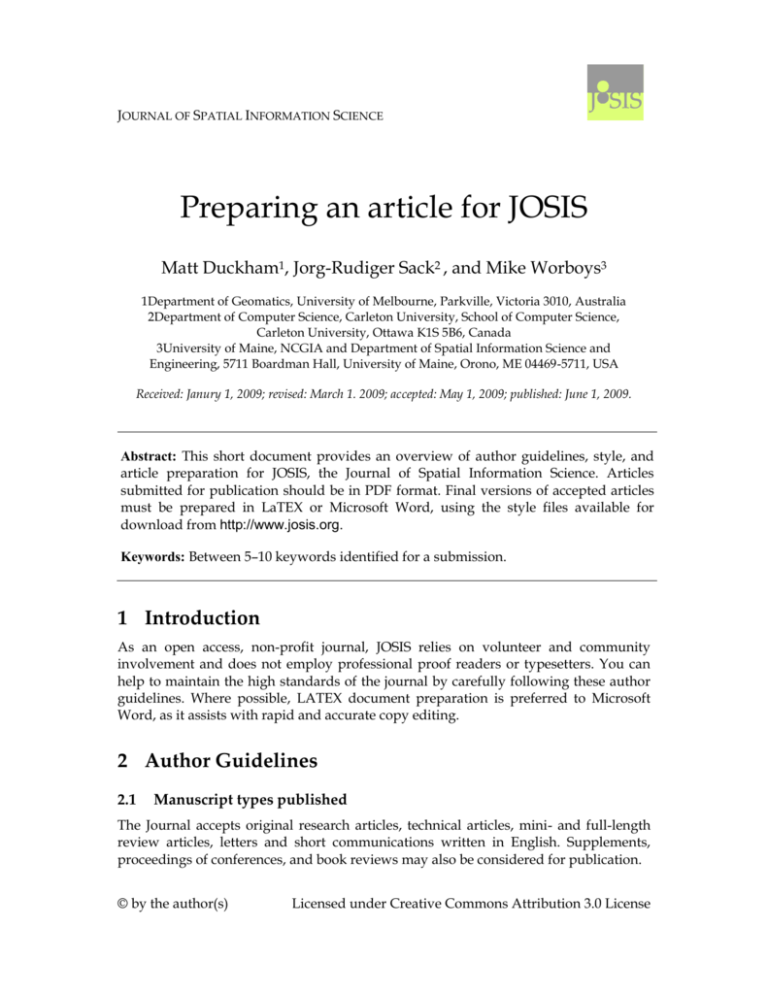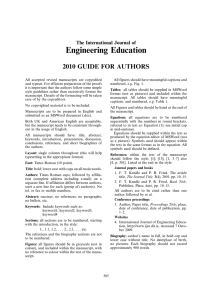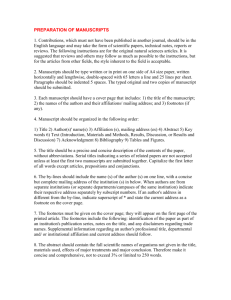1 Introduction - Journal of Spatial Information Science
advertisement

JOURNAL OF SPATIAL INFORMATION SCIENCE Preparing an article for JOSIS Matt Duckham1, Jorg-Rudiger Sack2 , and Mike Worboys3 1Department of Geomatics, University of Melbourne, Parkville, Victoria 3010, Australia 2Department of Computer Science, Carleton University, School of Computer Science, Carleton University, Ottawa K1S 5B6, Canada 3University of Maine, NCGIA and Department of Spatial Information Science and Engineering, 5711 Boardman Hall, University of Maine, Orono, ME 04469-5711, USA Received: Janury 1, 2009; revised: March 1. 2009; accepted: May 1, 2009; published: June 1, 2009. Abstract: This short document provides an overview of author guidelines, style, and article preparation for JOSIS, the Journal of Spatial Information Science. Articles submitted for publication should be in PDF format. Final versions of accepted articles must be prepared in LaTEX or Microsoft Word, using the style files available for download from http://www.josis.org. Keywords: Between 5–10 keywords identified for a submission. 1 Introduction As an open access, non-profit journal, JOSIS relies on volunteer and community involvement and does not employ professional proof readers or typesetters. You can help to maintain the high standards of the journal by carefully following these author guidelines. Where possible, LATEX document preparation is preferred to Microsoft Word, as it assists with rapid and accurate copy editing. 2 Author Guidelines 2.1 Manuscript types published The Journal accepts original research articles, technical articles, mini- and full-length review articles, letters and short communications written in English. Supplements, proceedings of conferences, and book reviews may also be considered for publication. © by the author(s) Licensed under Creative Commons Attribution 3.0 License 2 DUCKHAM, SACK, WORBOYS 2.2 Manuscript Preparation Manuscripts must be written in English in a clear, direct and active style. All pages must be numbered sequentially. The manuscript should be submitted as a PDF file (letter size). For accepted manuscripts, complete article sources are required in Latex or Word format, with each figure supplied as separate files in .eps format. Latex and Word journal templates for manuscript submission are available for download from the journal web site. 2.3 Academic honesty Authors must certify that the manuscript is the authors’ own work and certify that the article has not been previously published, nor currently submitted for publication to any other outlet (print or electronic). Corresponding authors of manuscripts are required to certify that these conditions apply on behalf of all paper authors as part of the online submission process. 2.4 Conflict of Interest Any potential conflicts of interest should be clearly acknowledged in the covering letter. Any financial contributions or support for the work being reported should be listed in the manuscript acknowledgments. 2.5 Manuscript Sections Manuscripts for research articles and letters submitted to the respective journals should be divided into the following sections. Some variations to this model are acceptable where appropriate, for example in review articles in accordance with the requirements of the topic. 1. 2. 3. 4. 5. 6. 7. 2.5.1 Title Authors and affiliations Abstract Keywords Main text Acknowledgments References Title The title should be concise, and must not be more than 20 words. Authors should also provide a short “running title.” 2.5.2 Authors and Institutional Affiliations Authors are required to provide their full names and their institutional affiliations and addresses. www.josis.org Preparing an article for JOSIS 2.5.3 3 Abstract The abstract should summarize the essential features of the article, and must not exceed 250words for review and research papers or 150words for short papers or letters. Abbreviations should be avoided in the abstract, and references should not be cited in the abstract. 2.5.4 Keywords Your submission must include between five and ten keywords for your article. Accepted manuscripts must additionally specify further index terms as appropriate. 2.5.5 Main Text The main text should be divided into separate sections, and may be further subdivided according to the areas to be discussed. The manuscript style must be uniform throughout the text using 11pt Palatino font. The first appearance of any abbreviations in the text should be preceded by the full term, unless it is a standard abbreviation or unit of measurement. Reference numbers should be given in square brackets in the text. Non-assimilated words from Latin or other languages should also be italicized e.g., per se, et al. 2.5.6 Figures and tables Figures and tables must be numbered consecutively with a concise explanatory caption, and must be referred to in the main text with capitalized reference (e.g., “Figure 4” or “Table 2”). Figures and tables must appear in the text close to where they are first referred to in the main text (see Figure 1). Do not collect figures together at the end of the article. Authors of accepted articles will need to supply high quality versions of all figures as separate .eps (encapsulated postscript) files. 2.5.7 Acknowledgments Please acknowledge anyone (individual/company/institution) who has contributed to the study, including substantial contributions to the conception, design, acquisition of data; analysis and interpretation of data; drafting the manuscript; or provided critical comments resulting in revisions to content. For each author, please list the source(s) of any funding or financial contributions related to the study. 4 DUCKHAM, SACK, WORBOYS Figure 1: Changes in temperature and humidity over the course of one day 2.5.8 References References must be listed in the numerical system (ACM). Citations must be numbered sequentially [in square brackets] in the main text in alphabetical order. Full numbered references must be listed in the reference section. The reference numbers must be finalized and the bibliography must be fully formatted before submission. Examples of citation styles included in the bibliography for this document include journal articles [1, 2], edited and authored books [6, 5], articles in proceedings and collections [4, 7], technical reports and booklets [8, 3]. 3 References [1] DIJKSTRA, E. A note on two problems in connexion with graphs. Numerische Mathematik 1 (1959), 269–271. [2] EGENHOFER, M., AND FRANSOZA, R. Point-set topological spatial relations. International Journal of Geographical Information Science 5, 2 (1991), 161–174. [3] GENERAL ASSEMBLY OF THE UNITED NATIONS. Universal declaration of human rights. United Nations Resolution 217 A (III), December 1948. [4] KARP, B., AND KUNG, H. T. GPSR: Greedy Perimeter Stateless Routing for Wireless Networks. In MobiCom ’00: Proceedings of the 6th Annual International Conference on Mobile Computing and Networking (New York, NY, USA, 2000), ACM Press, pp. 243–254. [5] MANDELBROT, B. Fractals, Form, Chance and Dimension. Freeman, San Francisco, 1977. [6] MILLER, H. J., AND HAN, J., Eds. Geographic Data Mining and Knowledge Discovery. CRC Press, 2001. www.josis.org Preparing an article for JOSIS 5 [7] MONTELLO, D. R. A new framework for understanding the acquistion of spatial knowledge in large-scale environments. In Spatial and Temporal Reasoning in Geographic Information Systems, M. J. Egenhofer and R. G. Golledge, Eds. Oxford University Press, New York, 1998, ch. 11, pp. 143–154. [8] RODDEN, T., FRIDAY, A., MULLER, H., AND DIX, A. A lightweight approach to managing privacy in location-based services. Tech. Rep. Equator-02-058, University of Nottingham, Lancaster University, University of Bristol, 2002.








